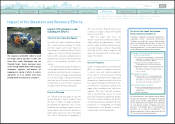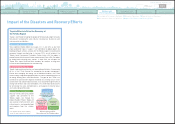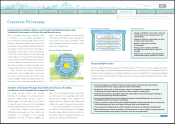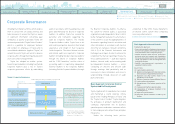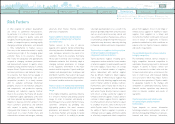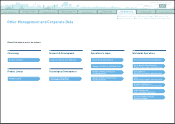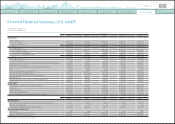Toyota 2012 Annual Report Download - page 40
Download and view the complete annual report
Please find page 40 of the 2012 Toyota annual report below. You can navigate through the pages in the report by either clicking on the pages listed below, or by using the keyword search tool below to find specific information within the annual report.
Investor InformationToyota Global Vision Special FeaturePresident
ʼ
s Message Financial Section
Business and
Performance Review
Medium- to Long-Term
Growth Initiatives
Changes for Making
Ever-Better Cars Management and
Corporate Information
TOYOTA ANNUAL REPORT 2012
including sensitive data, and to manage or
support a variety of business processes and
activities, including manufacturing, research
and development, supply chain management,
sales and accounting. In addition, Toyota
ʼ
s
vehicles may rely on various digital and
information technologies, including information
service and driving assistance functions.
Despite security measures, Toyota
ʼ
s digital and
information technology networks and systems
may be vulnerable to damage, disruptions or
shutdowns due to attacks by hackers, computer
viruses, breaches due to unauthorized use,
errors or malfeasance by employees and others
who have or gain access to the networks and
systems Toyota depends on, service failures or
bankruptcy of third parties such as software
development or cloud computing vendors,
power shortages and outages, and utility
failures or other catastrophic events like natural
disasters. Such incidents could materially
disrupt critical operations, disclose sensitive
data, interfere with information services and
driving assistance functions in Toyota
ʼ
s vehicles,
and/or give rise to legal claims or proceedings,
liability or regulatory penalties under applicable
laws, which could have an adverse effect on
Toyota
ʼ
s brand image and its financial condition
and results of operations.
Toyota is sensitive to fluctuations in foreign
currency exchange rates and is principally
exposed to fluctuations in the value of the
Japanese yen, the U.S. dollar and the euro and,
to a lesser extent, the Australian dollar, the
Canadian dollar and the British pound. Toyota
ʼ
s
consolidated financial statements, which are
presented in Japanese yen, are affected by
foreign currency exchange fluctuations through
both translation risk and transaction risk.
Changes in foreign currency exchange rates
may affect Toyota
ʼ
s pricing of products sold and
materials purchased in foreign currencies. In
particular, strengthening of the Japanese yen
against the U.S. dollar can have an adverse
effect on Toyota
ʼ
s operating results. The
Japanese yen has been appreciating against
major currencies including the U.S. dollar in
the past year. If the Japanese yen continues to
appreciate against major currencies, including
the U.S. dollar, Toyota
ʼ
s financial condition and
results of operations may be adversely affected.
Toyota believes that its use of certain
derivative financial instruments including
interest rate swaps and increased localized
production of its products have reduced, but
not eliminated, the effects of interest rate and
foreign currency exchange rate fluctuations.
Nonetheless, a negative impact resulting from
fluctuations in foreign currency exchange rates
and changes in interest rates may adversely
affect Toyota
ʼ
s financial condition and results of
operations.
Increases in prices for raw materials that Toyota
and Toyota
ʼ
s suppliers use in manufacturing
their products or parts and components such
as steel, precious metals, non-ferrous alloys
including aluminum, and plastic parts, may
lead to higher production costs for parts and
components. This could, in turn, negatively
impact Toyota
ʼ
s future profitability because
Toyota may not be able to pass all those costs
on to its customers or require its suppliers to
absorb such costs.
Should the world economy suddenly deteriorate,
a number of financial institutions and investors
will face difficulties in providing capital to the
financial markets at levels corresponding to
their own financial capacity, and, as a result,
there is a risk that companies may not be able
to raise capital under terms that they would
expect to receive with their creditworthiness. If
Toyota is unable to raise the necessary capital
under appropriate conditions on a timely basis,
Toyota
ʼ
s financial condition and results of
operations may be adversely affected.
The worldwide automotive industry is subject
to various laws and governmental regulations
including those related to vehicle safety and
environmental matters such as emission levels,
fuel economy, noise and pollution. In particular,
automotive manufacturers such as Toyota are
required to implement safety measures such
as recalls for vehicles that do not or may not
comply with the safety standards of laws and
governmental regulations. In addition, Toyota
may, in order to reassure its customers of the
safety of Toyota
ʼ
s vehicles, decide to voluntarily
implement recalls or other safety measures
even if the vehicle complies with the safety
standards of relevant laws and governmental
regulations. Many governments also impose
tariffs and other trade barriers, taxes and
levies, or enact price or exchange controls.
Toyota has incurred, and expects to incur in
the future, significant costs in complying with
these regulations. If Toyota launches products
that result in safety measures such as recalls,
Toyota may incur various costs including
significant costs for free repairs. Furthermore,
new legislation or changes in existing legislation
Financial Market and Economic Risks
Toyota's operations are subject to currency
and interest rate fluctuations. Political, Regulatory,
Legal and Other Risks
The automotive industry is subject to
various governmental regulations.
High prices of raw materials and strong
pressure on Toyota's suppliers could
negatively impact Toyota
s profitability.
The downturn in the financial markets could
adversely affect Toyota
s ability to raise
capital.
Risk Factors
Search NextPrev page 40
Contents
0821
Other Management and Corporate Data
Corporate PhilosophyR&D and Intellectual Property
Corporate Governance
Management Team
Risk Factors


